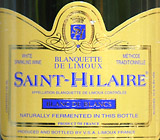|
This article was published in The 30 Second Wine Advisor on Monday, Nov. 13, 2006.
Historic bubbly
The Benedictine monks of Limoux in Southwestern France, it is said, invented the world's first sparkling wine in 1531, well over a century before another Benedictine, Dom Pierre Pérignon, perfected the more familiar fizzy wine that caught the world's attention as Champagne.
There's no real question that Limoux's ascendancy is real ... but the world's first bubbly had to be a very different wine from the cork-popping Champagne and other sparkling wines as we know them today.
A simple question says it all: What did they put it in? Even during Pérignon's era in the late Seventeenth and early Eighteenth Century - much less a century earlier in Limoux - modern glass bottle and cork technology were in their infancy, and fermentation science wasn't understood at all. Even as late as the early 1800s, according to Hugh Johnson in Vintage: The Story of Wine, as much as 80 percent of Champagne production was lost to bottles exploding in the chalk cellars beneath Reims and Epernay, victims of flawed bottle glass, out-of-control fermentation ... or both.
Fizz was a natural occurrence in the tartly acidic white wines of both Limoux and Champagne, where fermentation would re-start in the barrels every spring after activity had halted during winter's cold. But in the custom of the time, these wines weren't routinely bottled. The light, fragile and hand-made bottles of the 1500s would have been utterly inadequate to the task of containing a modern Champagne; it wasn't until the 1630s, Johnson writes, that Sir Kenelm Digby, an Englishman, came up with a process for blowing bottles sturdy enough to hold sparkling wine at any acceptable level of risk. Only with the Industrial Revolution a century after that, followed by Pasteur's research into fermentation a generation later, could Champagne finally be produced consistently and bottled with real safety.
So what kind of a wine was sparkling Limoux during the 1500s? The rare Limoux sparkler called "methode ancestrale" ("ancestral method") offers a clue: Slightly fizzy wine was put into bottles when fermentation wasn't quite complete, held in with a cork tied down with twine. A gentle fermentation would continue in the bottle, but would eventually cease when the wine's alcohol content remained at a low 5% or 6%, resulting in a frothy, yeasty and weak beverage with a substantial ration of murky sediment sitting on the bottom of the flask like a home-brewed beer. Even so, it's safe to assume that a lot of Limoux bottles exploded and that if the wine was exported, it wasn't exported far.
A small amount of methode ancestrale Limoux is still made by artisanal producers, but it's safely put into modern sparkling-wine bottles. Much more widely available, however, are Blanquette de Limoux and Crémant de Limoux, sparkling wines made by the Champagne method, using white grape varieties that include the regional grape Mauzac plus Chardonnay and Chenin Blanc.
Today's featured wine is a Blanquette de Limoux from the Aimery Sieur d'Arques winery, labeled Saint-Hilaire in the U.S. and Aimery Sieur d'Arques in the rest of the world. At $10, it's one of the best quality-for-value sparkling wines you'll find anywhere.
Clear pale gold, lasting stream of bubbles. Fresh and crisp, apples and just a touch of yeasty "rising bread dough" in the aroma and flavor. Creamy carbonated mouthfeel, dry and acidic; the sharp acid edge may make it a better table wine than for sipping after a toast - it's first-rate with an appropriate food match. U.S. importer: Jack Poust & Co., Inc., NYC. (Nov. 12, 2006)
FOOD MATCH: A tongue-in-cheek tribute to sparkling wine's versatility with food: Fresh-baked baguettes with local-farm bratwurst and Creole mustard.
VALUE: One of the best bubbly bargains around - Champagne quality at one-third the cost - and the $10 price has held locally since the 1997 vintage.
WHEN TO DRINK: Ready to drink, but it's certainly safe to keep it for a year or two on the wine rack or in the cellar.
PRONUNCIATION:
WEB LINK:
FIND THIS WINE ONLINE:
|
 Saint-Hilaire 2003 Blanquette de Limoux Blanc de Blancs Brut ($9.99)
Saint-Hilaire 2003 Blanquette de Limoux Blanc de Blancs Brut ($9.99)